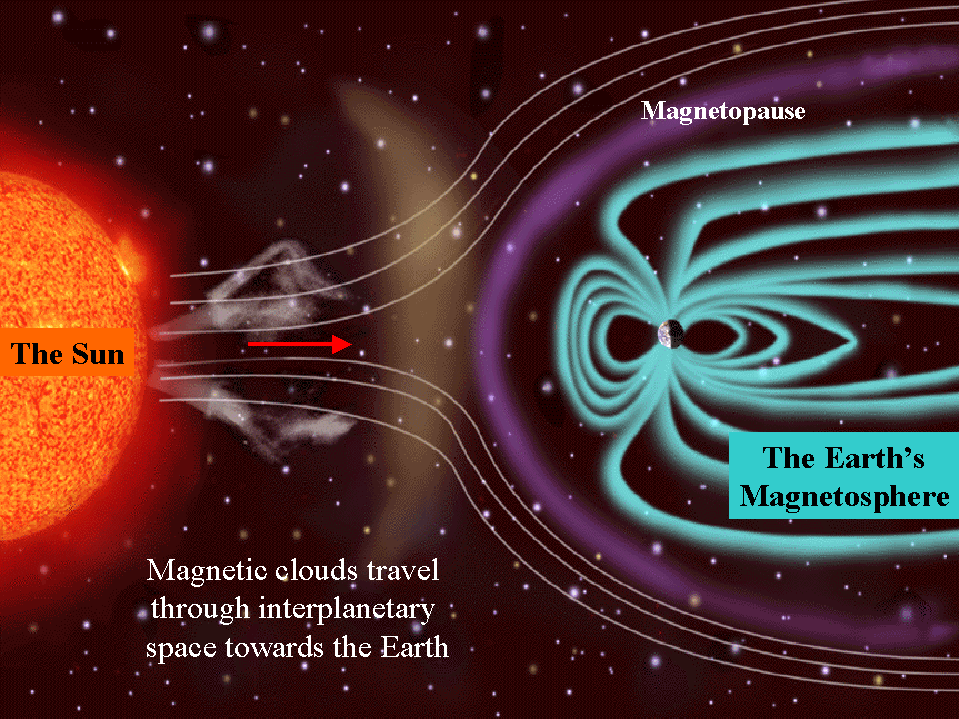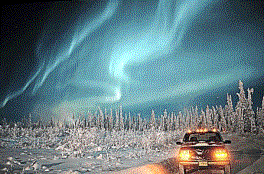
"But the Sun is 93 million miles away, how can it affect us?"
Many scientists around the world turn telescopes and satellites toward the Sun in order to be able to understand our nearest star. For centuries different civilisations have depended on the Sun for heat and light to live. However, the Sun effects the Earth in more ways than enabling us to keep warm and grow food. Now that you have learnt about our star in the previous pages you can see that it is a very dynamic and active object. The explosions (flares and coronal mass ejections) on the Sun can cause highly energetic particles and millions of tonnes of very hot, electrified material to be expelled, sometimes on a collision course with Earth. This material also carries magnetic field from the Sun which is very important when we are considering how the material will affect the Earth. If this material manages to break its way into the Earth's normally protective atmosphere (the magnetosphere) we can see many effects on Earth. The bi-polar magnetic field of the Earth points north but the field contained within the material expelled form the Sun can point in any direction. When the field is orientated in the opposite direction to that of the Earth, that is when it points south, the 2 magnetic systems interact and the solar material can enter the Earth's magnetoshpere.

This picture shows the Sun and the Earth's magnetoshere- NOT TO SCALE!. The boundary where the solar material meets the magnetosphere is called the magnetopause.
The most famous effect is the Aurora and it can be
seen around the polar latitudes when the upper atmosphere becomes excited by
energetic electrons from the storms on the Sun. When the Earth's environment is
affected by activity from the Sun we call it a geomagnetic storm and variations in the Earth's magnetic field occur.

The number of sunspots on the Sun follows the solar cycle, but in the 17th century a strange event happened where during a period of 70 years from 1640 to 1710 almost no sunspots were observed. British astronomer E. Walter Maunder realised that this period coincided with an absence of the aurorae on the Earth. It has also been recorded that the Earth suffered a slight decrease in temperature during this time and colder weather ensued. Northern Europe went through a period now known as the Little Ice Age. Both are results of changes in the activity level of the Sun.
Today the Sun affects our lives in many more ways as we utilize current technology. Hundreds of satellites orbit the Earth, both for scientific and commercial uses and events from the Sun affect their performance. Low energy particles from the Sun can charge up the surface of the satellite, and when these events discharge they cause damage to surface materials and interfere with electrical devices. More energetic particles can travel through the surface of the satellite and damage the instruments inside. Solar flares produce many highly energetic protons which can reach the Earth in 30 minutes. During a geomagnetic storm the Earth's atmosphere gets heated and an increased drag on the satellites is felt. With this extra resistance the spacecraft slow down and lose altitude, they could quite literally drop out of the sky!! To compensate for this manouvers must be carried out by the satellite to re-adjust it's orbit back to a stable one. Aswell as using satellites to communicate we also use radio waves. These travel through space from the emittor, such as a TV mast, to the receiver, such as your televsion set, by being bounced off the ionosphere (part of our atmosphere). The ionosphere contains charged particles and during a geomagnetic storm it is disturbed and we can lose our radio signals!
Astronauts who orbit outside of the earth's atmosphere can be exposed to a large doses of radiation during a large solar storm. Even with their eyes shut the energetic particles hit their retina and cause sparkles of light! Passengers flying in commerical jets at high latitudes in the atmosphere are also exposed to higher radiation levels.
Extra...... Check out the Space Environment Centers Frequently asked Questions Page.
Reasons for studying the Sun stretch far out into space aswell. It is our nearest star and its proximity provides heat and light to maintain life on Earth, as well as being a unique laboratory to test our theories of the evolution of other stars and the formation of galaxies. On the Sun we are able to resolve features and study physical processes in a way that is impossible with more distant stars and astrophysical objects. Solar studies have enabled us to determine that other stars also have spots and hot coronae. It is the most powerful particle accelerator in the solar system, accelerating ions up to tens of GeV and electrons to hundreds of MeV in flares and CMEs. Similar energy release and particle acceleration mechanisms occur in sites ranging from planetary magnetospheres to active galactic nuclei. By studying the processes on the Sun we can begin to understand these other objects. Our studies of the interior of the Sun confirmed that fusion was occurring in the core but threw up a paradox: the observed neutrino flux was 3 times smaller than predicted by the best solar models. Resolution of this paradox came through helioseismology studies which showed that modifications to the existing particle physics theories were required.